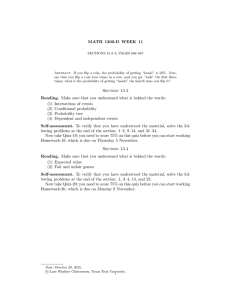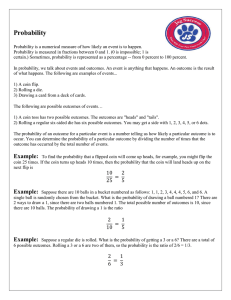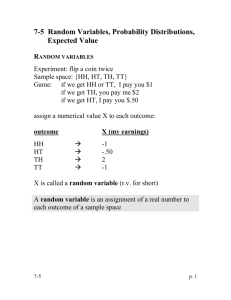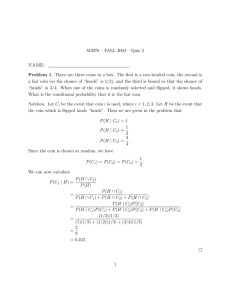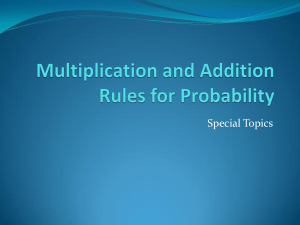“Do You Like Brussels Sprouts?” How to Implement Population Surveys with 1
advertisement
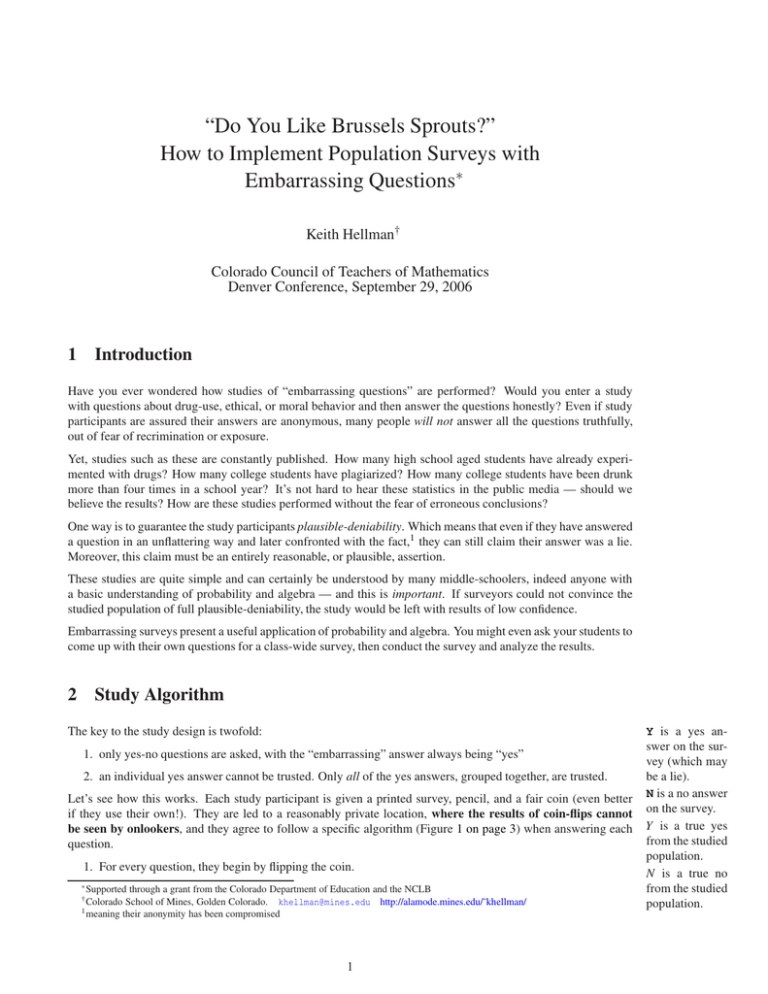
“Do You Like Brussels Sprouts?”
How to Implement Population Surveys with
Embarrassing Questions∗
Keith Hellman†
Colorado Council of Teachers of Mathematics
Denver Conference, September 29, 2006
1 Introduction
Have you ever wondered how studies of “embarrassing questions” are performed? Would you enter a study
with questions about drug-use, ethical, or moral behavior and then answer the questions honestly? Even if study
participants are assured their answers are anonymous, many people will not answer all the questions truthfully,
out of fear of recrimination or exposure.
Yet, studies such as these are constantly published. How many high school aged students have already experimented with drugs? How many college students have plagiarized? How many college students have been drunk
more than four times in a school year? It’s not hard to hear these statistics in the public media — should we
believe the results? How are these studies performed without the fear of erroneous conclusions?
One way is to guarantee the study participants plausible-deniability. Which means that even if they have answered
a question in an unflattering way and later confronted with the fact,1 they can still claim their answer was a lie.
Moreover, this claim must be an entirely reasonable, or plausible, assertion.
These studies are quite simple and can certainly be understood by many middle-schoolers, indeed anyone with
a basic understanding of probability and algebra — and this is important. If surveyors could not convince the
studied population of full plausible-deniability, the study would be left with results of low confidence.
Embarrassing surveys present a useful application of probability and algebra. You might even ask your students to
come up with their own questions for a class-wide survey, then conduct the survey and analyze the results.
2 Study Algorithm
The key to the study design is twofold:
1. only yes-no questions are asked, with the “embarrassing” answer always being “yes”
2. an individual yes answer cannot be trusted. Only all of the yes answers, grouped together, are trusted.
Let’s see how this works. Each study participant is given a printed survey, pencil, and a fair coin (even better
if they use their own!). They are led to a reasonably private location, where the results of coin-flips cannot
be seen by onlookers, and they agree to follow a specific algorithm (Figure 1 on page 3) when answering each
question.
1. For every question, they begin by flipping the coin.
∗ Supported
through a grant from the Colorado Department of Education and the NCLB
Colorado School of Mines, Golden Colorado. khellman@mines.edu http://alamode.mines.edu/˜khellman/
1 meaning their anonymity has been compromised
†
1
Y is a yes answer on the survey (which may
be a lie).
N is a no answer
on the survey.
Y is a true yes
from the studied
population.
N is a true no
from the studied
population.
2. Next, they read the survey question, and if their truthful answer is Y , they answer Y on the survey form.
3. If their truthful answer is N, they consult their coin flip. If it is heads, they lie, and answer Y on the survey
form. If the coin flip is tails, then they answer N on the survey form.
A study participant has one way of answering N, if his truthful answer is N. Every time a participant writes a Y
on the questionnaire, it may be because his coin-flip was heads. Thus, every participant has plausible-deniability
for each Y answer provided.
It might be useful to raise some questions about why this algorithm is so important, and how it protects the survey
participant from exposure.
• Why must the coin be flipped for each question? Isn’t it a waste of time if the answer is already yes?
Suppose you’re taking the test in the far corner of the room, far enough such that your coin flip results
cannot be seen by anyone. I’m sitting on the other side of the room with a copy of the survey — if you
don’t flip your coin for each question, I will know what your answers are. How? First, I count the number of
times you write answers on your survey, in this way, I know which question you are on. Then I simply keep
track of which questions you don’t flip the coin for, since you would only not flip the coin for questions you
would answer Y to, I know your Y questions.2
• Why must the survey questions be posed as the embarrassing answer always being yes?
It’s those words again: plausible-deniability. Run through the correct answer-logic algorithm with a poorly
formed question which has an embarrassing N answer (perhaps “Do you hate Brussels sprouts?”). If your
answer is truly N, and your coin flip is tails, you must answer N. Now imagine your anonymity is compromised, since the only way through the answer-logic which arrives at N is if your true answer is N, you
cannot fall back onto plausible-deniability and claim “the coin flip made me do it.” For completeness, consider a properly formed question, such as “Do you like Brussels sprouts?” You really do, so you answer the
survey honestly with a Y. Now, again, suppose your anonymity is compromised and you are brought before
congressional hearings. When asked about your purported love of Brussels sprouts you answer “Brussels
sprouts! Echk! I don’t like Brussels sprouts, I answered Y because my coin flip was heads!”
• Why can’t the alternative answering logic shown in Figure 1 be used?
This answer is the same as the answer above. Run through the logic and you’ll see that the alternative,
incorrect, algorithm has Y answerable only if Y is a person’s true answer. The incorrect algorithm does not
provide plausible-deniability to a study participant.
3 Survey Analysis
You are hopefully convinced that the described study methods provide participants with the plausible-deniability
needed to receive honest survey answers. But how can these results be used when an unknown fraction of the Y
answers are lies?
Let’s look at the answer to just one question, and what happens to the truthful fraction of Y and N answers inside
the answer logic (Figure 2 on page 4). In this figure, we know the fraction of Y s and Ns existing in the population,
and based on this, we can predict the count of Ys and Ns measured by the study. Is it possible to go backwards?
If we know the counts of Ys and Ns from a survey question, can we work backwards to an estimate of the true
fraction of Y s and Ns in the population? Sure we can!3
Let p be the percent, or probability, of a survey question having a truthful Y in the population. Then the fraction
of Ns will be 1 − p. If each survey participant follows the “answer logic” instructions,4 there are two sources
of Y answers: The first source is the percent of truthful Y s in the population, or pn, where n is the number of
participants in the survey. The second source is from the participants that would truthfully answer N ((1 − p)n),
since these participants flip fair coins, we expect this number to be about 12 (1 − p)n. Now we can write an equation
for y, the survey’s expected number of Y answers.
2 Granted, this type of distance eavesdropping may be difficult to pull off, but it is plausible enough to explain why it is best to flip the coin
for each single question.
3 I’ll present a simplified approach later (Section 4 on page 5), one that is perhaps better suited for middle-school math.
4 And we expect them to, because this provides them the plausible-deniability if their anonymity is compromised.
2
p is the percent,
or probability,
of a survey
question having
a truthful Y in
the population
n is the number
of participants
in the survey
y is our survey’s
expected
number of Y
answers
Correct
Wrong
Flip Coin
What is
Your Truthful
Answer to the
Question?
Flip Coin
Yes
What is
Your Truthful
Answer to the
Question?
Answer
“Yes”
Answer
“No”
Yes
No
What is Your
Coin Flip?
No
Heads
What is Your
Coin Flip?
Answer
“Yes”
Heads
Answer
“No”
Tails
Tails
Answer
“Yes”
Answer
“No”
Figure 1: Answer Logic. The left-hand algorithm is correct. The right-hand algorithm (differences highlighted in
red) does not offer study participants plausible-deniability, why not?
y
y
n
y
n
y 1
−
n 2
y 1
−
n
2
y 1
2
−
n 2
p
=
=
=
=
=
truthful N
1 z }| {
(1 − p)n
|2 {z }
Y from fair coin flips
solving for p . . .
1
p + (1 − p)
2
1 1
p+ − p
2 2
1
p− p
2
1
p
2
truthful Y
z}|{
pn +
=
p
=
2y
−1
n
(1)
Let’s examine Equation 1 more closely. If we ask a question for which every survey participant would answer Y,
then we’ll have a total of n Ys, or y = n, and our calculation of p would be:
p=
2n
−1 = 2−1 = 1
n
3
Question: Do You Like Brussel Sprouts?
Survey Size: 200 participants
% of Truthful YES’s in Survey: 12%
% of Truthful NO’s in Survey: 100-12=88%
Flip Coin
100%
What is
Your Truthful
Answer to the
Question?
Yes
12%
Answer
“Yes”
(0.12)·200 = 24
100-12=88%
No
Heads
What is Your
Coin Flip?
1
2 ×88%
Answer
“Yes”
(0.44)·200 = 88
1
2 ×88%
Tails
Answer
“No”
(0.44)·200 = 88
Figure 2: The Yes-No Flow. Survey results for a hypothetical question with known answer probabilities through
the answer logic.
100% (or 1.0 in decimal) is certainly the expected result. What if we ask a question for which every participant
would answer N? In this case, we expect y = n2 (everyone answers according to the coin flip, and we expect half
the coin flips to be heads):
2n
n
p = 2 −1 = −1 = 1−1 = 0
n
n
Again, we arrive at a reassuring answer.
Figure 3 on the following page shows the relationship between the number of Y answers and the estimated true
population fraction (p) — but how can p be negative? Let’s look at Equation 1 on the previous page again. When
will it emit negative values for p?
2y
−1 < 0
n
2y
< 1
n
2y < n
n
y <
2
Equation 1 on the preceding page emits negative values for p when y < n2 . We have already discovered this
case! When everyone in the study has a truthful N answer, about half of them will write down Y due to the coin
flip. We don’t expect the heads-to-tails ratio of all the coin flips to be precisely 1:1, so there may be a question
where the Y answer count is less than 2n — this simply indicates that nobody in the study had a Y answer to the
4
p vs. Y Count
1
p=
2y
n
n = 200
−1
p
0.5
0
-0.5
-1
0
50
100
150
200
Survey Y Count
Figure 3: A plot of the study estimated Y fraction (p) against the number of Y answers. The graph is for a study
of size n = 200. The red line shows that a count of about 125 Ys suggests a population Y fraction of 25%.
question.5
If you are concerned about obtaining usable results from a classroom survey,6 consider the graphs in Appendix A
on the next page and the confidence intervals you would like for the results. You may need to have multiple
classes take the same survey, and use questions with a high anticipated p to improve accuracy (they don’t need to
be embarrassing questions). Keep in mind that this type of study is usually implemented with ns on the order of
one or two thousand participants.
4 Simplified Equations
Equation 1 does not have to be derived by a middle-school classroom. Instead, you may wish to keep the analysis grounded in the straightforward logic of the algorithm and the mathematical computations that flow from
it:
truthful N
truthful Y
z}|{
1 z }| {
pn +
y=
(1 − p)n
|2 {z }
Y from fair coin flips
After your survey has been tallied, you will know n, suppose it is n = 150.
1
y = 150p + (1 − p)150
2
(2)
Have them prepare a table of y versus p and graph the relationship in Equation 2. Then find p for each survey
question graphically.
For each question, y is known. For instance, if n = 150 and y = 102, then
1
102 = 150p + (1 − p)150
2
(3)
5 There is a subtlety in this derivation that must be mentioned. We are treating y and Y as the same number, but they are truly different. y is
the expected number of Ys given p, whereas Y is simply the number of Ys for a survey question. y is a theoretical value, Y is a real, tangible
number. It turns out that Y represents a very good estimator of y, I believe it would be the maximum likelihood estimate (although I haven’t
bothered with the derivation), so we use the two terms interchangeably.
6 Or in other words, knowing the inherent uncertainty in your survey results.
5
Have them use calculators and attack the problem numerically. Beginning at a number for p near 0.5 and successively trying better guesses until Equation 3 on the previous page is satisfied.
I think the two best simplifications have been suggested by teachers at CCTM. The first is to simply subtract the
count of question Ns from the survey Ys to determine the true number of Y s. Then determining p is straightforward:
Ys − Ns
p=
n
The second embraces the “let the algorithm guide them” notion to the hilt. Let the students figure out their own
technique for determining p from the count of Ys and Ns. Some may find it via guess and check, some may find
a linear relationship, and some may subtract the Ns.
A
Study Confidence Intervals
Since coin flips are used,7 there is always a little bit of error in the measurement of p. The N branch of any study
question is more likely to have an uneven-even heads-to-tail split than a perfect 1:1 result. Despite this “wiggle”
or uncertainty, statistics is able to place bounds on the confidence of these study results.
The number of Y answers is given by
truthful Y
z}|{
y=
pn +
truthful N
1 z }| {
(1 − p)n
|2 {z }
Y from fair coin flips
The 12 in this equation is a simplification, because a perfect heads-to-tail split from the coin flips is unlikely. This
number is actually a random variable representing the number of heads from (1 − p)n fair coin tosses, which
is a binomial distribution with (1 − p)n trials and a success probability of 12 . The mean and standard deviation
of a binomial distribution is (b subscripts are used to distinguish from similar variable names elsewhere in the
document):
µ = nb pb
p
σ = nb pb (1 − pb)
In this case, nb = (1 − p)n and pb = 21 ,
1
µ = (1 − p)n
2
r
1
1
1p
(1 − p)n (1 − ) =
(1 − p)n
2
2
2
A 95% confidence interval (z = 1.96) is given by
σ=
µ ± zσ
1
zp
(1 − p)n ±
(1 − p)n
2
2
And we may rewrite our expression for y as
zp
1
(1 − p)n
y = pn + (1 − p)n ±
2
2
n pn
zp
= pn + −
±
(1 − p)n
2
2
2
p
z
pn n
(1 − p)n
+ ±
=
2
2
2
7 You
could also use TI calculators’ random number generators, but you will still have this problem.
6
The following graphs show the original y vs p relationship (red line) with 95% confidence intervals (green lines)
for varying study sizes (n). Note how both the study size (n) and the fraction of the population answering Y affect
the confidence intervals.
If a question in a study with 80 participants (n = 80) had 55 Ys, the interpretation would be:
• p (for this question) is near 0.38
• if the study was repeated 100 times, we would expect other estimated values of p to fall within the interval
0.28 < p < 0.46 for 95 of the 100 studies.
7
p vs. Y Count
n = 20
p vs. Y Count
0.8
0.8
0.6
0.6
n = 30
p
1
p
1
0.4
0.4
0.2
0.2
0
0
10
12
14
16
18
20
16
18
20
Survey Y Count
p vs. Y Count
22
24
26
28
30
75
80
Survey Y Count
n = 50
p vs. Y Count
0.8
0.8
0.6
0.6
n = 80
p
1
p
1
0.4
0.4
0.2
0.2
0
0
25
30
35
40
45
50
40
45
50
Survey Y Count
p vs. Y Count
55
60
65
70
Survey Y Count
n = 120
p vs. Y Count
0.8
0.8
0.6
0.6
n = 200
p
1
p
1
0.4
0.4
0.2
0.2
0
0
60
70
80
90
100
110
120
100
120
Survey Y Count
p vs. Y Count
140
160
180
200
900
1000
Survey Y Count
n = 500
p vs. Y Count
0.8
0.8
0.6
0.6
n = 1000
p
1
p
1
0.4
0.4
0.2
0.2
0
0
250
300
350
400
450
500
500
Survey Y Count
600
700
800
Survey Y Count
8
